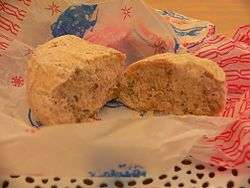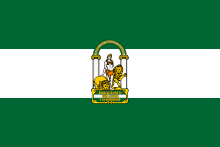Polvorón
|
Two halves of a polvorón | |
| Type | Shortbread |
|---|---|
| Place of origin | Spain |
| Region or state | Andalusia |
| Main ingredients | Flour, sugar, milk, nuts |
| Similar dishes | |
|
| |
A polvorón (From polvo, the Spanish word for powder, or dust; Cebuano: polboron; Tagalog: pulburón) is a type of heavy, soft and very crumbly Spanish shortbread made of flour, sugar, milk, and nuts. They are produced mostly in Andalusia, where there are about 70 factories in that are part of a syndicate that produces polvorones and mantecados.[1] Under the name mantecados, these sweets are a traditional preparation of other areas of the Iberian Peninsula as well.[2]
Polvorones are popular holiday delicacies in all Spain and its former colonies in Latin America and the Philippines. Traditionally, they were prepared from September to January but are now available all year round. Polvorones were brought to Spain by the Moors and there is thus a very possible Levantine origin, based on a similar sweet known as ghurayba.[3] As this was introduced by the Arabs, during the Spanish Inquisition, it was later decreed by the officials of the Inquisition that polvorones were to be made using pork fat as a means of detecting secret Jews and Muslims within the Southern Spanish regions.
Mantecado
Mantecado is a name for a variety of Spanish shortbreads that includes the polvorón. Often both names are synonymous, but not all mantecados are polvorones. The name mantecado comes from manteca, usually the fat of Iberian pig (cerdo iberico), with which they are made, while the name polvorón is based on the fact that these cakes crumble easily into a kind of dust in the hand or the mouth.
In Cuba, mantecado is an ice cream and in Spain it may be also the name given to a kind of sweet sherbet.[4] In the Philippines, mantecado is a popular and traditional ice cream flavour, characterised as a mixture of vanilla and butter. It was served during the 29 September 1898 luncheon banquet that followed the Malolos Congress' ratification of the Philippine Declaration of Independence in June that year.[5]
Regional variations
Cuba
In Cuba, it is one of the most common flavors of ice cream. Cuba, being the Latin American county in the Caribbean where Spain had the most interest and influence, has adapted the flavors of mantecado or polvorones from Spain into a delicious and beloved flavor for Cuban ice cream. Known worldwide for the delicious flavoring, what some might call a Latin Vanilla, this Cuban flavor has influenced ice cream flavors made in other Latin American places like in Puerto Rico.
Philippines
The Filipino version of polvorón, or pulvuron in the local vernacular, uses a large amount of powdered milk which is left dry, as well as toasted flour, and butter or margarine instead of lard. A number of local variants on the traditional polvorón recipe have been made. Well-known variants include polvorón with kasuy (cashew nut), with pinipig (pounded and toasted young green rice, similar to crisped rice) and with malunggay leaves. Strawberry, chocolate-coated, ube (purple yam), peanut, and cookies and cream flavoured polvorón also exist.
Spain
Polvorones are a common Christmas dessert in Spain. These days there are options different from pig fat, like cow fat, as well as vegetarian polvorones and mantecados made with olive oil.
United States of America
Sometimes called Pan de Polvo, it is made with anise in the south Texas region.
References
| Wikibooks Cookbook has a recipe/module on |
- ↑ Spanish mantecado: sweet treat beats economic downturn
- ↑ Herrera del Duque, Extremadura - Gastronomía
- ↑ Salloum, H. 2007. Classic Vegetarian Cooking from the Middle East and North Africa. Toronto: Interlink.
- ↑ Helado mantecado
- ↑ Dy-Zulueta, Dolly (21 November 2014). "Gene Gonzales recreates Malolos Congress dinner of 1898". InterAksyon.com (in English, Tagalog, and Spanish). Retrieved 10 January 2015.

